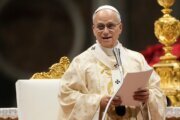Adding stops to the downtown Bethesda Circulator route is among the most common requests the Bethesda Urban Partnership gets.
The simple mechanics of running an efficient and popular 2.1-mile, 19- stop bus loop mean additional stops or routes aren’t coming immediately. But in a conversation about BUP’s 20-year anniversary, Executive Director David Dabney said new areas of redevelopment spurred by the ongoing Bethesda Downtown Plan could one day lead to some expansion.
“This is the biggest challenge strategically for us because the sector plan will really kind of outline any growth or potential growth,” Dabney said.
In 2006, BUP took over operation of the Bethesda Trolley as Ride On planned to shut it down. In 2011, BUP switched out the old-school trolleys for sleek, modern Circulator buses similar to the vehicles in downtown D.C.
Last month, the Bethesda Circulator service provided 31,000 passenger trips on the route that connects Woodmont Triangle, the Bethesda Metro and Bethesda Row.
BUP promotes the service as a way to get to and from Metro. But mostly, BUP hopes people use it as a way to park in less popular parking garages before hitching a ride to activity centers such as Bethesda Row.
“It was really built around that, as to how to move people and to mitigate traffic,” Dabney said. “You want to be able to move people from one end of town to the other.”
Some would like to see the Circulator expand its definition of where downtown Bethesda ends. The route now reaches Rugby Avenue at its northern-most point and Bethesda Avenue at its southern-most point.
Unsurprisingly, the bulk of the requests for expansion come from those looking for stops on Battery Lane and on Bradley Boulevard.
 The difficulty, Dabney said, is maintaining the system’s headway. BUP tested the idea of bringing the route east of Wisconsin Avenue during a recent winter holiday season. BUP pushed the route along Montgomery Avenue and East-West Highway and the shuttles showed a net loss in ridership, Dabney said.
The difficulty, Dabney said, is maintaining the system’s headway. BUP tested the idea of bringing the route east of Wisconsin Avenue during a recent winter holiday season. BUP pushed the route along Montgomery Avenue and East-West Highway and the shuttles showed a net loss in ridership, Dabney said.
There were some new riders, but some of the regulars didn’t like the changes and the idea of getting off an eastbound shuttle to wait for the next westbound one.
Now, the idea of a new “Pearl District” centered around Pearl Street is floating around in Bethesda Downtown Plan discussions. BUP Marketing and Communications Director said any master plan changes will have to be taken into account. The original concept for the Circulator was in the 1994 Bethesda CBD Master Plan (though in that process it was called a jitney).
“I think it’s a matter of what comes out of the plan and funding,” Coppula said. “Right now, we’re doing as mch as we can do based on the funding.”
BUP’s funding for the Circulator comes mostly from parking fees collected at public garages, lots and curbside meters in the downtown. There’s also some revenue that comes in from advertisement space on the shuttles.
Dabney said the more immediate improvements possible for the Circulator service involve technology that lets users know exactly when a shuttle will arrive at a particular stop. BUP and its Board are taking on the idea of establishing a phone app locator for Circulator shuttles.
“If you don’t wan to wait 10 to 15 minutes, which can happen if the shuttles are in traffic, I could see on my app where that Circulator is,” Dabney said. “I’ll go to Starbucks and get a coffee. If that could happen, I don’t think it would be that difficult to go to Bradley or Battery because then, they’d know when it would be there. They could time it.”
Circulator Map via Bethesda Urban Partnership








